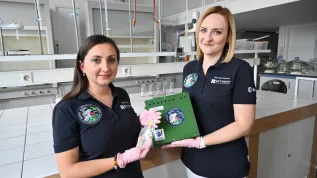
High school students from Słupsk have built their own mobile planetarium which can accommodate up to 30 people. Now they have an opportunity to present their idea at the conference at Stanford University in the US. But for now they are still raising funds for the trip to the United States.
The planetarium built by students from High School No. 1 in Słupsk can accommodate up to 30 people. The planetarium dome size is 6 meters.
It all started 10 years ago, when Wojciech Karcz - today employee of the Copernicus Science Centre - was still a high school student. The results of his passion for the challenges of the design included a ten meter foil bear and a Foucault pendulum. A month before graduation he decided to create a fully functional planetarium. Six-meter dome was made entirely of cardboard, and the star projector was powered by an old car battery from Fiat 126p.
Now Wojciech Karcz revisited the project with the current students of High School No. 1 in Słupsk, using currently available technology. Słupsk planetarium dome is made of PVC tubes, covered with an old parachute and darkened with foil. To create a star projector the students used an ordinary digital projector and a convex mirror. The planetarium is mobile - it can be easily disassembled and reassembled anywhere. It cost approx. 1.5 thousand zlotys, and the work took about three weeks.
High school students presented their planetarium at the June conference of the International Association of Planetariums - IPS, which took place in Warsaw. "In the course of our projections we were visited by people from all over the world, including representatives of Stanford University, who invited us to the conference >Fablearn<. The planned trip can provide a unique opportunity in our scientific development and will be a chance to present and disseminate the results of our original and innovative work to the world community" - explain the high school students.
During the conference at Stanford high school students will organise a workshop, during which together with participants they will build a planetarium according to their own design. "We want to show the international community of teachers and educators that this type of project is a great tool for teaching physics, astronomy and mathematics in a very interesting way" - write the planetarium creators.
To finance the group\'s trip to the US, the creators of the mobile planetarium launched a crowdfunding campaign, in which they want to raise 28 thousand zlotys by October 7.
Read more about the project and the crowdfunding campaign at: https://polakpotrafi.pl/projekt/planetarium-ze-slupska-jedzie-na-stanford
PAP - Science and Scholarship in Poland
ekr/ mrt/
tr. RL













